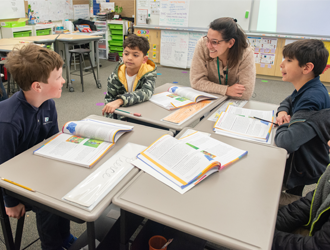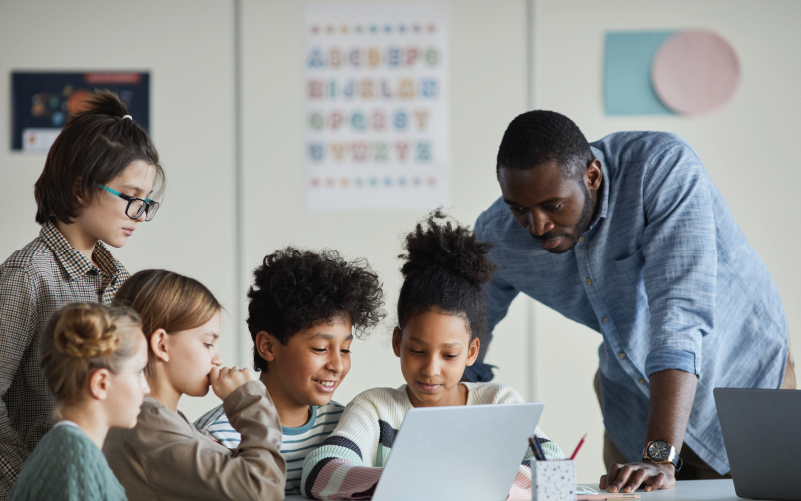Maintaining Learning Spaces

The space where students learn is incredibly important. This space can be individual or collective, online or in-person, and it can serve to facilitate or hinder learning (Damşa et al., 2019). Factors such as the type of furniture, the amount of clutter, the surface area of a worktable or desk, the lighting, and even the acoustics have been shown to impact how well students learn (Granito & Santana, 2016). The learning environment presents an opportunity. We can strive to create safe, engaging spaces that promote student learning while meeting the needs of their developing bodies and minds (Eitland et al., 2021).
As students and teachers alike have adapted to the demands of the COVID-19 pandemic, it’s likely that nearly every learning environment has undergone some type of change. Perhaps you’ve had to rearrange your classroom to accommodate social distancing guidelines, or maybe you’ve been completely remote and had minimal input in the learning space students have constructed at home. No matter where student learning is taking place right now, we can help to create and maintain a learning space that ensures students are set up for success.
When constructing a learning space, consider the space as a resource for learning. How can the learning space be constructed to help a student learn? By viewing a learning space as an integrated aspect of a student’s experience, one where the materials, resources, and the space itself work together to allow a student to make meaning of their lessons, we can help them to construct a space that will facilitate deeper learning. Even though students may be learning virtually and spending more time sitting with their screens than they would in a classroom, the learning space can still be thought of as an active space where students are striving to reach their learning goals (Damşa et al., 2019).

Below, explore some quick tips for creating and maintaining a supportive, engaging learning space for your students:
- Allow students choice in creating their space. A learning space should be co-constructed by the student, which allows students to exercise agency in their learning (Damşa et al., 2019) and affords them the chance to think critically about what helps them learn. Do they need lots of stimuli and personalization, or will they work better with a minimalist setup? Help a student think through the process of setting up a learning space: what will they need to succeed? What obstacles do they anticipate? Brainstorm how to use what you already have on hand to create a space that is uniquely their own but also conducive to learning.
- Remove distractions. Especially when students are learning at home, creating a space free of distractions when possible will help them remain engaged with their material and achieve deeper levels of understanding (Granito & Santana, 2016). This can mean putting phones or devices away during class sessions or ensuring that toys are out of sight while students learn. Students also must be mentally and physically prepared for class to avoid internal distractions: plan out snacks, brain breaks, restroom breaks, and rest/outside time between virtual classes so students are prepared when they log online.
- Pay attention to the details. In the quick pivot to distance learning, few of us were likely prepared for transforming our personal space into work and school spaces as well. While it may be impossible to create a perfect space for students to learn at home, perfection isn’t the goal. Taking small steps can have a big impact on the learning space. Factors such as lighting and view, temperature, dust, and noise can positively or negatively influence learning (Eitland et al., 2021). Be sure students have an extra layer to put on if they get cold during class time, and adjust screen brightness is appropriate for the lighting in the room. Have regular discussions with students to discuss what’s working and what isn’t. Perhaps they need additional lighting, a different type of seat, or some other small change that will help them succeed. At the end of each day, work with your students to tidy their spaces so they’re ready for the next day: wipe down screens, clean up snacks, and put materials neatly away. Maintaining an at-home learning environment may seem like a big task amidst the many other tasks we’re juggling these days, but even small changes can make a big, positive difference.
- Change it up. Novelty in a space can wake up the brain and capture student attention (Persaud, 2014). Try switching up small, manageable aspects of a student’s at-home learning environment. Perhaps you switch out a photo in a frame that may be on their desk or switch up the background on their device. Try having a creativity night, where students create their own posters related to their learning and hang them in their space. When they move on to a new unit, they can create new posters. It doesn’t need to be a big change to afford students a fresh perspective and reinvigorate their desire to learn.

Maintaining a student’s learning space is certainly no easy feat. But we can take small steps to keep the space neat and clean. Learning spaces are also an opportunity to spark students’ creativity and connect with their learning on a new level. Rather than viewing it as one more task to check off the list, see how you can delegate some of the responsibility to the student and let their responsibility skills shine. Discover their natural inclination for creating a learning space and note what works and what doesn’t. This information will be valuable to the learner long after the pandemic ends, as they will have a clearer understanding of how they learn best. And most importantly, avoid getting overwhelmed by keeping in mind that small tweaks matter: a simple desk wipe down or a brighter light bulb can help a student thrive.
References
- Damşa, C., Nerland, M., & Andreadakis, Z. E. (2019 July 11). An ecological perspective on learner-constructed learning spaces. British Journal of Educational Technology, 50(5), 2075–2089. https://doi.org/10.1111/bjet.12855
- Eitland, E., Klingensmith, L., MacNaughton, P., Laurent, J. C., Spengler, J., Bernstein, A., & Allen, J. G. (2021). Schools for health: Foundations for student success: how school buildings influence student health, thinking and performance. Harvard T.H. Chan School of Public Health. https://forhealth.org/Harvard.Schools_For_Health.Foundations_for_Student_Success.pdf
- Granito, V. J., & Santana, M. E. (2016). Psychology of learning spaces: Impact on teaching and learning. Journal of Learning Spaces, 5(1). https://pdfs.semanticscholar.org/76ea/acc789035177e32ad5fdf5d353d2cc6a8622.pdf?_ga=2.254903112.1745924733.1616100056-108895830.1616100056
- Persaud, R. (2014, September 8). Why learning space matters. Edutopia. https://www.edutopia.org/blog/why-learning-space-matters-ramona-persaud








